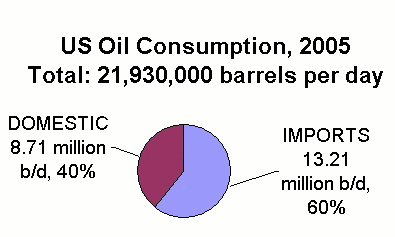
Some interesting oil industry statistics - consumption
©1997-2009 Gibson Consulting
Index
US imports - from where?
US imports - volume
US exports
Largest exporters
Largest importers
Iraq
By company
Leading countries
US Production
Leading US States
Largest world oil fields
Largest US oil fields
Largest world gas fields
US Production Peak
Production Peak
Number of wells
US - Wells drilled/producing
US - shut-in wells
How many gallons?
How much gasoline?
How much plastic?
Production costs
Finding costs
US Gov't profits
Uses of oil
World
US
US - Bakken
US - shut-in wells
Peak Oil
Drill Baby Drill
Largest world oil fields
Largest US oil fields
Largest world gas fields
Who sets the price?
Price history
Factors
Why so high?
Gasoline price breakdown
Historic change in pricing basis


 US OIL DEMAND, 2004: Over 20 million barrels
per day, up from January 2002, when demand was about 18.5 million barrels
per day, = 777 million gallons. If lined up in 1-gallon cans, they
would encircle the earth at the equator almost 6 times (about 147,000 miles of
cans) — every day. Here's another image: EVERY DAY, the US consumes
enough oil to cover a football field with a column of oil 2500 feet tall. That's
121 million cubic feet. 55-60% of US consumption is imported at a cost of
$50 billion+ per year, amounting to the largest single element of our trade
deficit. In summer 2004, thanks to higher prices, increased demand, and lower
production, record trade deficits of more than $50 billion per month were recorded,
with approximately 30% of that attributable to imported energy costs. In
September 2004, the US reported its lowest monthly oil production in 55 years,
at an average of 4.85 million barrels per day.
US OIL DEMAND, 2004: Over 20 million barrels
per day, up from January 2002, when demand was about 18.5 million barrels
per day, = 777 million gallons. If lined up in 1-gallon cans, they
would encircle the earth at the equator almost 6 times (about 147,000 miles of
cans) — every day. Here's another image: EVERY DAY, the US consumes
enough oil to cover a football field with a column of oil 2500 feet tall. That's
121 million cubic feet. 55-60% of US consumption is imported at a cost of
$50 billion+ per year, amounting to the largest single element of our trade
deficit. In summer 2004, thanks to higher prices, increased demand, and lower
production, record trade deficits of more than $50 billion per month were recorded,
with approximately 30% of that attributable to imported energy costs. In
September 2004, the US reported its lowest monthly oil production in 55 years,
at an average of 4.85 million barrels per day.
